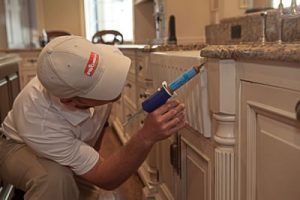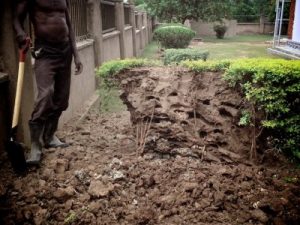
Termites inside the house is something many homeowners are afraid of.
But, hold the panic, there’re so many treatments nowadays that fighting the infestation is not as hard of a task as it once seemed.
But before we list the possible solutions, let’s figure out which pest we’re actually fighting.
Hide content
- How to get rid of the termites inside the house?
- Useful articles
Normally, there’re two termite families that are threatening the household.
First one – are the drywood termites. They nest in the same wood that they eat, and that makes them easier targets for some of the treatments.
Learn more about drywood termites: signs of their activity; best methods of treatment: spot treatment and DIY methods; how to get rid of them in furniture?
Another story are the subterranean termites, those ones are settling their colony in the soil, normally not too far away from the house. So, once you got rid of the insects at home, you will have to figure out how to destroy the nest, not to let the termites re-enter immediately.
Learn more about subterranean termites: signs of their activity; best methods of treatment and DIY methods. Eastern subterranean termites and their tunnels and tubes with photo.
Identification of this two families is not easy, and the best is if you can lay a hand on the winged reproductives, appearing in times of the swarm.
In this case you’d better collect some samples of insects, dead or alive, or even simply the wings shed, and bring them to the pest control office for the identification.
If you don’t have a microscope and entomological experience, I wouldn’t recommend to make it yourself.
Another way of figuring out the type of your termite invaders, is to analyze the signs.
The covered carton corridors, usually connecting the ground with the wooden elements, cracks or crevices, are a certain sign of the subterranean termites.
Also if you see a swarm emerging from under the soil – it means at least the presence of the subterranean colony on your land.
Common sign for the drywood termites is frass. It’s pellets of looking like saw dust excrements of the termites. If you found some, try to clean it and monitor if it will reappear on the same spot – in this case you have an active drywood termite infestation.
Advice! If you’re not experienced with termites, call for the pest specialist at least this first time to explain you what are the infestation signs, how to search for them and what do they mean.In the end, for getting rid of termites inside your house, you can use the same treatments for both termite families. But, remember, in case of the subterranean infestation, this will be only half of the full extermination job and you should look at the soil treatments and baiting systems afterwards.
Here you can learn more information about termite bait systems: Advance, Green, CSIRO, Nemesis, Exterra, Firstline, Terminate. Also find out how to make baits by yourself and how to refill them?
How to get rid of the termites inside the house?
There’re many different types of products and methods that you can use to kick the termites miles away from your house. The possible solutions to your problems are:
Structural tenting
Structural tenting is a treatment with almost 100% guarantee of full termites’ extermination inside the structure. This is no DIY technique and should be executed by professionals.This is how it’s done:
- The house is prepared for the fumigation. The food is sealed in plastic, plants and pets are removed, people leave the house for couple of days.
- The whole building is being covered with the giant tent.
- The gas, usually, sulfuryl fluoride is released under the tent and penetrates all of the structure, killing even the termites that are otherwise unreachable.
- After about 72 hours, during which the professional is monitoring the tent with special equipment to avoid the gas leak, the people can come back to the house. The gas leaves no traces and doesn’t have a residual action.
Here you can learn more information about tenting: dangers for termites, preparing for fumigation and cleaning after, how long does this procedure last?
If you decide to use this method you can be sure that all the termites and their colonies, residing in the house are gone, and now you can concentrate on the prevention of them coming back. This is the best treatment for the house with multiple drywood infestations.
Fumigation with termite bombs
Termite bombs is basically a DIY version of the simplified fumigation technique. The same idea – you need to place the object, that is infested in the enclosed space, for example your garage. Make sure there’ll be no leak through the windows or door and release the gas.
Don’t waste time – you should leave fast not to expose yourself to the insecticide.After certain time you have to open the windows and aerate the chamber before entering. Now, as the manufacturer promises, all that is left to do is to clean the dead insects from the floor.
Heat and cold treatments
Termites don’t like both extreme cold and extreme hot temperatures. To kill termites this way is, maybe, the most environmentally responsible way to do it. Usually, though, it can be used only on small objects or wooden elements.
For the cold treatment you can either place the infested object in the freezer, sealed in bag for the wood not to absorb the humidity. Or you can cool the object down with nitrogen.
The heat treatment can be performed in different ways. The most extreme way – is to burn the object. In case it’s an easily replaceable doorsill or other element, this might be the easiest thing to do.
If the wood is too damaged to restore – burn it and you’ll destroy the colony as well. Otherwise you can use the oven to heat up the object, just make sure this handling wont damage the lacquer or paint, if there’s some.
Sometimes enough thing to do is to place the infested object under the direct sun for a while. For example, if this is a subterranean termites’ infestation, this way you cut the workers in the wood off their nest, and take away their source of moisture.
Soon enough all the insects inside the object will die naturally. Just make sure you are not placing it directly on the ground, unless you are planning the feast for termites.Wood treatments
There’re many different chemical or non-chemical substances the can be used for the wood treatment and different ways of their application. Let’s start with termiticide chemicals.
There’re three ways of application of those:
- Spray.
- Brush.
- Foam.
Here you can learn more information about effective termite control remedies: Bora-Care, Boric acid, Borate, Fipronil, Chlorpyrifos, Chlordane, Borax, Timbor, Termidor, Terminator, Phantom, Lorsban, Biflex, Terro. You can choose different forms, such as – foam, liquid, powder.
Spray will be the least efficient of those. The best is to use it for the preventive wood treatment, and choose the insecticide with repellent action.
Termiticide applied with a paintbrush goes deeper in the wooden structure and might be more efficient for the fighting back an active infestation. But, the foam is the most interesting way.
For the foam treatment you can buy a ready-to-use aerosol can or prepare it yourself from the liquid insecticide, using a special equipment. The best thing about the foam is that it rapidly expands over 20 times and penetrates through all the corridors and galleries of the nest, reaching all of the colony members.
The simplest way is to inject the foam in the kick holes or cracks made by termites themselves. But additionally, you can drill some holes in the wood, to make sure the insecticide will be delivered to the colony’s heart.
But then, some people prefer the all-green ways of fighting the termites and will not use strong insecticides like Termidor, in fear to harm the wildlife. For this people there’re plenty of natural termiticides amongst the essential oils.
The most famous for this is the orange oil. They should be applied in their liquid form, through the termite made or specially drilled holes. They also can be used with the mist spray, but for the preventive treatment. In this quality it should be sometimes renewed.
Boric Acid is a middle ground between strong chemicals and natural oils. Not too dangerous for the environment is normally listed among eco-friendly solutions. It can also be applying with the spray or paintbrush.
Advice! If you know how to work with the wood sealant – it’s a good final touch, after the termiticide wood treatment performance.Useful articles
If you interested in more information of termites we recommend you to read the following articles:
- All types of termites. Are they harmful to humans? Can they bite you? And what is the difference between drywood and subterranean ones?
- What does swarmers of different species look like: drywood, subterranean, formosan?
- Signs of infestation outside and in the house: in walls or furniture.
- How to treat them in the yard: in wood or in fence. How long this process lasts and what is pre-construction and soil treatment?
- What does termite holes look like? What is droppings and is it toxic to humans? Do termites make noises?
- Posible termite damage, how does it look like? Examples of damage in walls and wood floors.
- All about flying termites: how do they look like, swarming season and what to do if there are swarmers in your house?
- How do they do nests and mounds? How to find it in your garden or inside the house?
- Termite life cycle – from egg to larvae. And social hierarchy: workers, soldiers, queen.
- Did you know that termites can infest living trees, for example a palm or a pine tree. They also like to live in stumps.
- You can prevent the infestation by using barriers, such as: HomeGuard, Physical systems, Safeguard, Stainless steel mesh, Kordon.
- If you want to get rid of termites naturally, learn more about such methods as: heat or cold treatment, orange oil, using nematodes.

